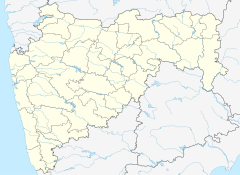Ulhasnagar railway station
| Mumbai Suburban Railway station | |||||||||||
 | |||||||||||
| General information | |||||||||||
| Coordinates | 19°13′N 73°09′E / 19.22°N 73.15°E | ||||||||||
| Elevation | 16.250 metres (53.31 ft) | ||||||||||
| Owned by | Ministry of Railways, Indian Railways | ||||||||||
| Line(s) | Central Line | ||||||||||
| Other information | |||||||||||
| Fare zone | Central Railways | ||||||||||
| History | |||||||||||
| Electrified | Yes | ||||||||||
| Services | |||||||||||
| |||||||||||
| |||||||||||
| |||||||||||
Ulhasnagar is a railway station on the Central line of the Mumbai Suburban Railway network.

Ulhasnagar
Ulhasnagar ( Marathi:उल्हासनगर ) is a city located in the Thane district in the state of Maharashtra. This city is part of Mumbai Metropolitan Region managed by MMRDA. It had an estimated population of 506,098 at the 2011 Census.[1]
Ulhasnagar is considered as one of the largest denim jeans manufacturer. It has number of small businesses, manufacturing quality denims with an effective cheap labour. Some of the manufacturers export jeans worldwide from Ulhasnagar.[2] The city is also famous for its furniture market, cloth market and electronic market.
According to the 2011 Census of India,[4] Ulhasnagar had a population of 506,098. Males constituted 53% of the population and females 47%.
Ulhasnagar is a municipal town and the headquarters of the Tehsil bearing the same name. It is a railway station on the Mumbai-Pune route of the Central Railway. Ulhasnagar, a colony of migrants in the aftermath of the Partition of India (1947), is 61 years old. Situated 58 km from Mumbai, the once-barren land has developed into an urban town of Thane district. Originally, known as Kalyan Military transit camp, Ulhasnagar was set up especially to accommodate 6,000 soldiers and 30,000 others during World War II. There were 2,126 barracks and about 1,173 housed personals. The majority of barracks had large central halls with rooms attached to either end. The camp had a deserted look at the end of the war and served as a ready and commercial ideal ground for Partition victims. Sindhis, in particular, began life anew in the new land.
After the partition of India, over 1,00,000 Sindhi-speaking refugees from the newly created West Pakistan were relocated to the deserted military camps five kilometres from Kalyan. The area was converted into a township in 1949 and foundation ceremony took place on 8 August 1949. The Governor-general of India, C. Rajagopalachari named the town Ulhasnagar (literally 'city of joy'; ulhas=joy; nagar=city).Sir Rajagopalachari also laid the foundation stone for the township. Not actually, it was called Ulhasnagar, because of its close proximity to Ulhas Plateau and its valley.
A suburban railway station was built in 1955. In January 1960, Ulhasnagar Municipality was formed, with Arjun K. Ballani as first chief, and a municipal council was nominated. In 1965, elections were first held in this council. Now this 28 square kilometre area has 389,000 people of Sindhi descent, the largest enclave of Sindhis in India. The town lies outside Mumbai city but within the Mumbai Conurbation. In 2010, the estimated population of Sindhi Hindus in Ulhasnagar was 400,000.[5] Ulhasnagar is one of the major exporter of jeans, clothes, School Bags and fabrics not just in India but all over the world. Monthly production of jeans here is more than 20 million.
Apart from this Ulhasnagar has various Small Scale Manufacturing units which produces Confectinary,Textile Weaving, Furniture, Printing Press etc.
In the late 1970s, Ulhasnagar was a populated lawless town settled by business class Sindhi refugees.[6] As the time goes by number of gangs were formed working under the patronage of political parties. In 1995 business turnover in Ulhasnagar estimated at Rs.10 billion (US$200 million) Consequently, many illegal projects raised up for which politicians started to charge money to look the other way, and by 1999, each corporator in the municipality was said to be making half or one million rupees in "protection money".[7]
One can reach Ulhasnagar by road or railway. Ulhasnagar railway station is on the Central Line of the Mumbai Suburban Railway. One can reach Ulhasnagar by alighting at either of Kalyan and Shahad Station which are near camp 1 and 2 or Ulhasnagar and Vithalwadi Railway Stations which are close to 3 and 4 or Ulhasnagar and Ambernath Railway Stations are near to camp 4 and 5.[citation needed] The city is serviced by City Bus and autorickshaw for travel from Mumbai, Bhiwandi & Thane as well. Recently "Ulhasnagar Municipal Transport Service" was launched in 2010 wherein mini buses ply from Kalyan Railway Station to kailash Colony in Ambernath near David's Cottage covering almost full Ulhasnagar. There are auto rickshaws and municipality buses for transportation.[citation needed] Since Mid of 2013 the bus service launched became almost inoperative and to travel in Ulhasnagar the only option is auto rickshaws
References
- Dionne Bunsha (17 December 2004). "The States:Ulhasnagar in a new role". The Hindu. Retrieved 24 May 2007.
- "About Ulhasnagar, Introduction of Ulhasnagar, Ulhasnagar Profile". www.ulhasnagaronline.in. Retrieved 2016-01-09.
- [1]
- Sindhi conversions in Ulhasnagar raise a storm
- Girish Kuber (2007-01-09). "Pappu's Ulhasnagar gambit may backfire". Economic Times. Retrieved 2007-05-24.
- Yogesh Pawar (3 March 1999). "Three Ps rule Ulhas: Pelf, Politicians & Pappu.and his most trusted man shamsher ansari Ulhasnagar is mainly distributed in 5 areas namely ulhasnagar * 1,2,3,4 and 5". Indian Express. Retrieved 24 May 2007.



